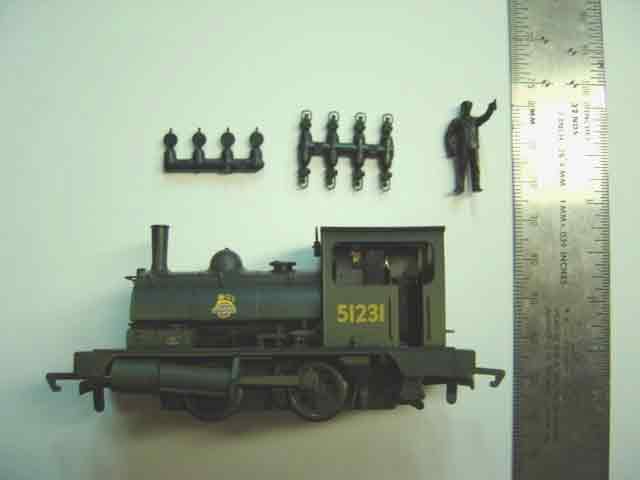R2335 is simply the Hornby catalogue number for this model
BR:
BR means "British Railways". This was the name of the government-owned national railway system in Britain during the years 1948 to 1994. Our new switching locomotive bears the emblem of British Railways on its side.
--more--

The Observer's Book of Railway Locomotives of Britain" (1964: Frederick Warne & Co. Ltd.), published during the British Railways era, describes our new locomotive on page 120. The book tells us that when British Railways acquired this locomotive and all its brothers, the identification numbers 51200 through 51253 were assigned to them. As you can see from the photograph, our locomotive is number 51231.
The book also explains that before British Railways acquired these locomotives, they belonged to an earlier railway: the London, Midland & Scottish Railway (LMSR). Before the LMSR owned them, the locomotives all belonged to the Lancashire and Yorkshire Railway (L. and Y.R.). The locomotives were designed by J. A. F. Aspinall, and were first brought into service in December, 1891.
0-4-0ST:
0-4-0 means that the locomotive has no wheels in the front, four wheels in the middle (two on each side), and no wheels in the rear. The "Flying Scotsman" locomotive, by contrast, has four wheels in the front, six wheels in the middle, and 2 wheels in the rear. The "Flying Scotsman" is thus known as a 4-6-2. This code is known as the "Whyte classification system", because it was invented by Mr. F. M. Whyte of the New York Central Railroad in America.
The letters ST after the 0-4-0 stand for "saddle tank". This simply means that this little locomotive carries its own water in a tank shaped like a saddle. The "saddle tank", as you can see from the picture, fits like a saddle over the top of the boiler.
Pug
We don't really know what Pug stands for, but we believe that this was simply a pet name for this little locomotive, perhaps because it resembles an English "pug" dog. If you look at a picture of an English pug dog, you might be able to see a resemblance to the locomotive.
Other things in this picture:
In the picture, we see little plastic models - a man dressed in a uniform, and some railway lanterns. The directions that were packed with the Pug tell us that the man in uniform is the "locomotive driver" (in America, he would be called the "engineer"). The directions also reveal that the two different kinds of lanterns represent the two styles of lantern used by the different railways that owned the locomotive at different times. One style of lantern was used by British Railways (BR), while the other style was used by the London, Midland & Scottish Railway (LMSR). However, the directions do not state which lantern was used by which railway. The layout builder has done a lot of research to determine which lantern was used by which railway, but, until he is absolutely certain which is which, he refuses to affix the lanterns to the locomotive, for fear of inviting the ridicule of the many thousands of locomotive lantern experts whose essays on the subject appear in the World Wide Web.
The ruler shown in the picture indicates that the locomotive driver is probably in 00 scale (1/76 scale) as opposed to HO scale (1/87 scale). If you place the driver alongside the ruler, he stands at a height of about 24 millimeters. In 00 scale, 24 millimeters represents approximately six feet. In HO scale, 24 millimeters represents almost 7 feet. Although the designer feels that a height of 6 feet is more probable than a height of 7 feet, he is unwilling to take a firm stand on this point at this time.
Go to top of page